Table of Contents
INSPIRING IMAGINATION
Of course, almost any book is an inspiration for the imagination…
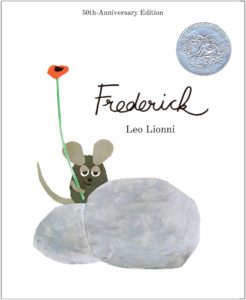
|
In Leo Lionni’s Frederick (Dragonfly Books, 1973), while all the other field mice scurry about collecting food for the winter, Frederick – a talented and imaginative little mouse – dreamily sits, watches, and thinks, explaining that he is gathering color, warmth, and words for the cold days ahead. Finally winter comes, and as food stores run low and spirits droop, Frederick revives them all with his wonderful poems and stories filled with colorful images of the spring and summer. For ages 3 and up. |
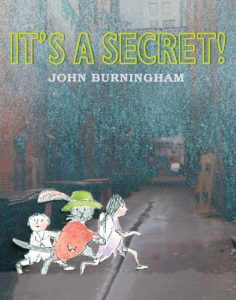
|
In John Burningham’s It’s a Secret (Candlewick, 2009), Marie-Elaine wonders where her cat, Malcolm, spends the night – and discovers, on a magical journey, that Malcolm, wearing a hat with a plume, celebrates at midnight parties with the Queen of the Cats. (Where do you think cats go at night? Invent your own story.) For ages 3 and up. |
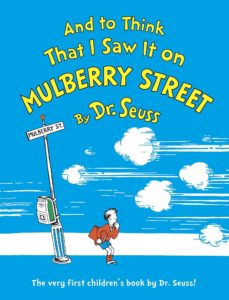
|
Dr. Seuss’s rollicking And To Think That I Saw It On Mulberry Street (Random House Books for Young Readers, 1989) is a tale of imagination run amok: Marco hasn’t seen anything on the way home from school but a horse and a wagon (“That can’t be my story. That’s only a start.”) – so he proceeds to add imaginative embellishments, each more fabulous than the last. Marco is a born writer. For ages 3-8. |
| Learn more about And To Think That I Saw It On Mulberry Street at NPR’s How Dr. Seuss Got His Start. | |
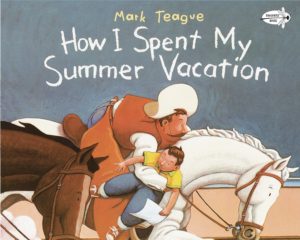
|
In Mark Teague’s rhyming picture-book How I Spent My Summer Vacation (Dragonfly Books, 1997), young Wallace Bleff – giving a class report on a blah, but classic, back-to-school writing topic – explains that he was sent out west for the summer to recover from a too-wild imagination. His story then spirals into an improbable (but cool) account of a kidnapping by cowboys and a barbecue threatened by a cattle stampede, in which “Kid Bleff” heroically saves the day. For ages 4-8. |
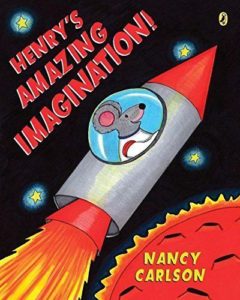
|
In Nancy Carlson’s Henry’s Amazing Imagination (Puffin, 2010), Henry – an extremely imaginative mouse – regales his class at show-and-tell with fabulous stories of pet dinosaurs, giant snowmen, and visiting aliens. Accused of lying, Henry is crushed, until he discovers how to channel his amazing imagination into writing stories. For ages 4-8. |
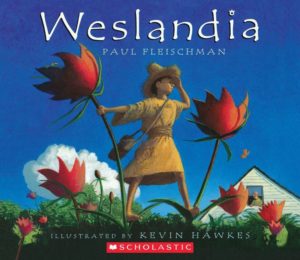
|
Writing is often a matter of creating imaginative new worlds. A wonderful example of this is found in Paul Fleischman’s Weslandia (Candlewick, 2002), in which young Wesley – an ususual boy who dislikes pizza and refuses to shave half his head like all the other boys – spends his summer vacation creating a whole new civilization. (Try it.) A wonderful read for ages 4 and up. |
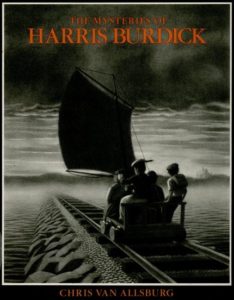
|
Chris Van Allsburg’s The Mysteries of Harris Burdick (Houghton Mifflin, 1984) is a marvelous picture book: eerie, evocative, inspiring, and utterly fascinating. It consists of fourteen enchanting black-and-white pictures, each with a mysterious title and line or two of text. “Mr. Linden’s Library,” for example, shows a girl asleep with an open book, from which a leafy vine is now sprouting. “He had warned her about the book,” the text reads. “Now it was too late.” “Uninvited Guests” pictures a cellar: at the bottom of the stairs, light from a window falls on a tiny wooden door. (“His heart was pounding. He was sure he had seen the doorknob turn.”) For ages 4 and up. |
| From ReadWriteThink, The Mysteries of Harris Burdick is a lesson plan in which kids write mystery stories based on the pictures in the book. | |
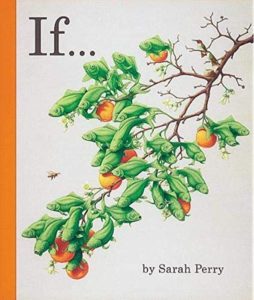
|
Sarah Perry’s If… (J. Paul Getty Museum, 1995) pairs a simple text with fascinating surrealistic paintings: If zebras had stars and stripes…If mice were hair…If spiders could read Braille…If cats could fly…If the moon were square…Irresistible. For ages 4 and up. |
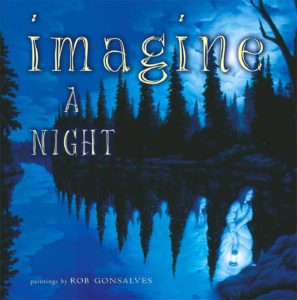
|
Sarah L. Thomson’s magical Imagine books – Imagine a Night (Atheneum Books for Young Readers, 2003), Imagine a Day (2005), and Imagine a Place (2008) – illustrated with evocative and surreal paintings by Ron Gonsalves, are wonderful inspirations for stories, as moonlit reflections of pine trees turn into ghostly girls with lanterns; a toy train becomes life-sized; and sunflowers have human faces. For ages 9 and up. |
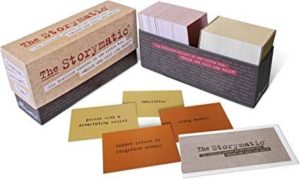 |
The Storymatic – “six trillion stories in one little box” – is touted as a writing prompt, a teaching tool, a parlor game, and a toy. It consists of a box of 540 cards in two colors. Players draw two gold cards to create a main character – say, “royalty,” “gravedigger ,” “caretaker of an elephant,” or “pig” – and two copper-colored cards as story starters, such as “invitation from a stranger,” “burning house,” “handcuffs,” “pet is behaving strangely,” or “talking doll.” The challenge: to write, tell, or co-invent a story based on your cards. Thought-provoking and addictive for ages 12 and up. Also see The Storymatic Kids! for ages 5 and up. |
 |
Think-ets – the “Tiny Trinket Imagination Game” – consists of a pouch or box of assorted (and entrancing) teeny objects: a miniature compass, a bottle, a gold ring, a shell, a polar bear, an airplane, a bird’s egg, a thimble. Combinations of the objects serve as story starters. |
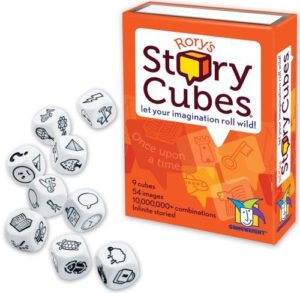  |
From Gamewright, Rory’s Story Cubes consists of nine dice, each with imagination-sparking images on each face – for example, a key, a magic wand, a mask, an apple, a shooting star. Roll them for story-generating combinations. |
